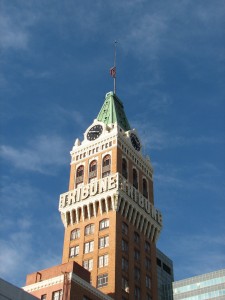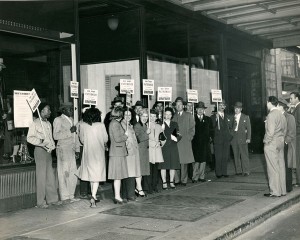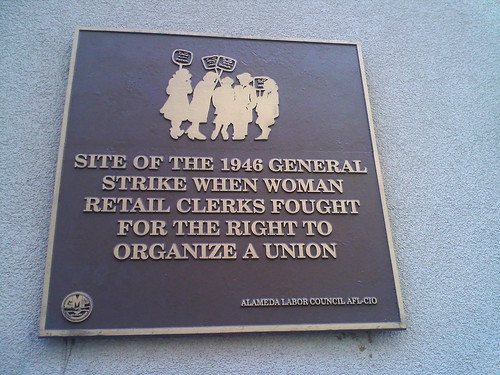Part two of our mapping series. See Part one Mapping Histories
History is never objective—interpretations of events always vary depending on whose perspective is prioritized. It is always a process of selection and exclusion, approved what is remembered and forgotten, talked about and written down, history is not left up to chance but to the choices of the record keepers and story tellers. The end of official history’s monolithic status as truth and the wide recognition of its non-objectivity now means there is always room for more detail and multiple co-existing accounts of the past. At its worst, this view of history is accused of perpetuating gross revisionism and at its best, allows a challenge to the status quo. The increase in social and oral histories attests that the record is always and necessarily incomplete, subject to scrutiny and revision, and thus always born political. It is with this understanding that the peculiarities of the local history tour and historical markers will be explored as contested forms of place-specific history. A history tour promotes certain perspectives as interpreted by the individual tour guide.

This article focuses on Oakland, California and its many competing history tours, each with their own versions of history and differing forms of representing it. A history tour is a type of public program, usually free or of minimal cost, found widely across different geographies, and often led by enthusiastic volunteers. The tours often promote civic pride, meet educational requirements, highlight city programs and projects, or boost support for local politicians. Other times they are used to promote various agendas of private organizations ranging from environmental non-profits to developer’s associations to architectural preservationists. The format and points-of-interest always correspond to what version of a story the organization wants to tell and the stories vary widely.
Oakland’s official history tours are run year round and sponsored by the City of Oakland’s Cultural affairs department. They sponsor a series of eight free history walks1 focusing on six different micro-neighborhoods near downtown and two thematic programs focused on churches and the African-American community respectively. These tours give a general introduction to the city blocks they cover, offering bits of architecture and famous names, but do not focus on the surrounding historical contexts. The contrast could not be more apparent when one compares this type of program with the annual SF Laborfest2 .
The San Francisco Bay Area Laborfest is an annual event that celebrates the history and struggle of organized labor in the Bay Area. The Oakland General Strike Walk3 , like many of the Laborfest events, takes the form of a history tour. This walk leads participants around a handful of significant sights in Oakland’s City Center, while narrating the history of the 1946 Oakland General Strike and emphasizing the sequence of events that culminated in the Strike.
In the autumn of 1946 a retail clerks union, comprised mostly of women, was denied a new contract and in response, four hundred clerks began a picket to protest working conditions. This conveniently occurred at the beginning of the holiday shopping season and the strike continued for a few weeks until city administrators and business leaders decided to break the strike. The attempt to break the strike and the ensuing police violence escalated the situation on the streets. Union protesters were quickly joined in solidarity by transit workers who stopped trains and buses and delivery drivers who would not cross the picket line. The dispute quickly swelled to over 100,000 participants. From the striker’s perspective, the labor dispute became a multi-day street party uniting a diverse group of workers in downtown Oakland4 . This history is an ugly scene from the official perspective because it was a large scale challenge to law-and-order. The government’s response was to hire strikebreakers and push aggressive policing tactics. There is now, after many years of effort, a plaque on the outside of Kahn’s (The Rotunda Building) on Broadway dedicated to the memory of the women retail workers whose picket initiated the 1946 Oakland General Strike—the only visible recognition that this event happened in the downtown area.
The above example is demonstrative of the difference between official history and “alternative” histories. Firstly, there is the matter of an event’s scale of importance, both to participants and to a wider community. Labor histories and other histories of community struggle seek to freeze moments in time: moments of relative strength, successes won, or the heroic failures of “what if…” These histories take a moment in time, explode it and analyze the fragments. A tour of this type uses this moment to show its localized geographic affects and any pock-marks left on the built environment. Sometimes these histories are tinged with sad nostalgia or calls to action by the historians themselves. With a tour like the General Strike Walk there is no claim for objectivity, it is proudly and nostalgically partisan. In contrast, official histories always claim objectivity by focusing on the general march of progress and change within a local geographic area, the flow of history existing without significant punctuated events. Any event that would be frozen and then exploded from below, to the official history is simply another tic on a cities timeline, equal to any other event that has happened. The power and significance of the event is denatured or depoliticized so it cannot serve as a model or as a lesson.
The popular perception of history presents the past is as primarily separate from the present and is of little value aside from trivia and academic pursuits. Walter Benjamin’s conception is that “History is the object of a construction whose place is formed not in homogeneous and empty time, but in that which is fulfilled by the here-and-now “5 as it is practiced, a living site of conflict. He also notes that all linear conceptions of time always benefit those in power. 6 It will be interesting to see in the coming months and years how the history of the Occupy movement is incorporated into Oakland’s history. Occupy Oakland’s significance, like the general strike of 1946 before it, will fade with time and the embarrassing way at which officials handled it will likely be mostly obscured and forgotten. What markers will be left to remember the occasion?
Place-marking and memorials are another lens to use when looking at local histories. Like the 1946 General Strike plaque, historical markers are neither objective nor are they always accurate. Another fairly recent example of place-marking was the 10,000 Steps project,7 which was funded mostly by the city, but executed by artist-researchers, Marksearch8 and a handful of non-profit community groups. The goal of 10K steps was to create a self-guided walking tour to highlight the history of downtown neighborhood parks. It combined historical markers with a website and pamphlet offering a perspective on how these neighborhoods have changed and why. It was, for the most part, told from the official perspective, although incorporated community input from residents of those neighborhoods. 10K Steps served the dual purpose of communicating local history and promoting the use of downtown parks along with the previous mayor’s redevelopment projects. Place marking is a common practice by artists and activists to alter and replace signage or make their own memorials for causes they take as their own.
History tours are a good place for intervention because they retain a relatively open format. Participants can interject with questions or additional information and rarely are tour guides invested in strong-arming their tour group. Local history organizations, history rooms, and small museums are often run by elders that are passionate about the subject and eager to interact with visitors. Since many younger people express little interest in history, especially site-specific histories like historical houses, landmarks, cemeteries, or parks, expressing any interest in these subjects will provides a space to build inter-generational relationships and the potential to shape future histories.
While highlighting the ways in which a tour is a site of contested meaning, the walking tour’s existence, for better or worse, is becoming quickly outmoded. Tours are easily augmented or even replaced by mobile technology with apps that access online maps, historical photos, or detailed information. While a physical tour provided a social/physical space for interaction, the loss of the physical tour also creates other opportunities for interventions in the virtual space it creates. Protest movements from Oakland to Egypt have used Google maps to rename plazas and civic landmarks. Websites and social media create a space in which to contest the official narrative. It is specious to argue that these virtual forms replace interventions in the real world but they do offer another arena for history-making.
What alternate history tours and guerilla place-marking, in both real and virtual space, can do is disrupt the official record. Alternate accounts of events attempt to short-circuit official memory, to confuse or to open a dialogue. The plasticity of history makes it a site ripe for intervention.
(1) Oakland Tours
(2) SF Laborfest
(3) Flying Picket Historical Society
(4) Stan Weir, “Account of the General Strike”
(5) Walter Benjamin, On the Concept of History XIV
(6) Walter Benjamin, On the Concept of History VII
With whom does the historical writer of historicism actually empathize? The answer is irrefutably with the victor. Those who currently rule are however the heirs of all those who have ever been victorious. Empathy with the victors thus comes to benefit the current rulers every time… Whoever until this day emerges victorious, marches in the triumphal procession in which today’s rulers tread over those who are sprawled underfoot. The spoils are, as was ever the case, carried along in the triumphal procession. They are known as the cultural heritage. In the historical materialist they have to reckon with a distanced observer. For what he surveys as the cultural heritage is part and parcel of a lineage which he cannot contemplate without horror. It owes its existence not only to the toil of the great geniuses, who created it, but also to the nameless drudgery of its contemporaries.
(7)10K Steps Project
(8)Marksearch

